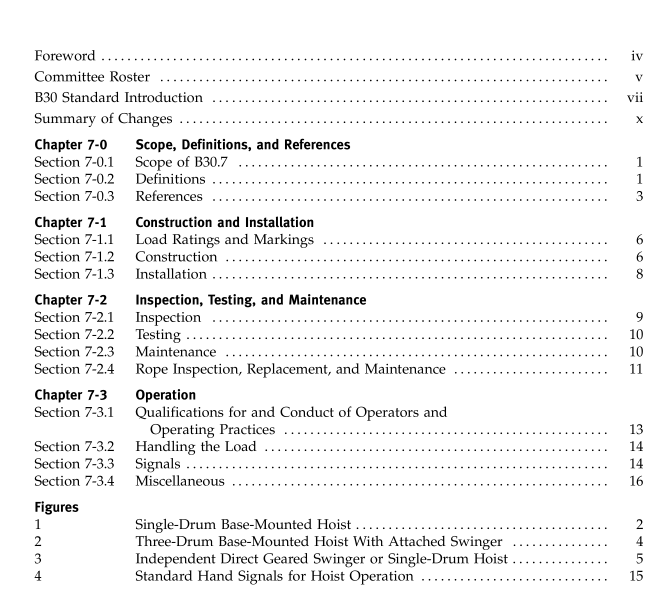ASME B30.7:2006 pdf free download Base-Mounted Drum Hoists
If adopted for governmental use, the references to other national codes and standards in the specific vol- umes may be changed to refer to the corresponding regulations of the governmental authorities.
The use of cableways, cranes, derricks, hoists, hooks, jacks, and slings is subject to certain hazards that cannot be met by mechanical means but only by the exercise of intelligence, care, and common sense. It is therefore essential to have personnel involved in the use and operation of equipment who are competent, careful, physically and mentally qualified, and trained in the safe operation of the equipment and the handling of the loads. Serious hazards are overloading, dropping or slipping of the load caused by improper hitching or slinging, obstructing the free passage of the load, and using equipment for a purpose for which it was not intended or designed.
The Standards Committee fully realizes the im- portance of proper design factors, minimum or max- imum sizes, and other limiting dimensions of wire rope or chain and their fastenings, sheaves, sprock- ets, drums, and similar equipment covered by the Standard, all of which are closely connected with safety. Sizes, strengths, and similar criteria are de- pendent on many different factors, often varying with the installation and uses. These factors depend on the condition of the equipment or material; on the loads; on the acceleration or speed of the ropes, chains, sheaves, sprockets, or drums; on the type of attachments; on the number, size, and arrangement ofsheaves or other parts; on environmental conditions causing corrosion orwear; and on many variables that must be consideredin each individual case.The rules given in the Standardmust be interpreted accordingly,and judgment used indetermining their application.
Some of the provisions of this Standard requirecompliance with information found in manuals or otherdocuments supplied by the manufacturer with the equip-ment. The information includes recommendations,re-quirements,and instructions (e.g.,“the reeving shall be checked for compliance with the recommendationsof the manufacturer’).
Compliance with the provisions should not precludethe possibility of consulting a qualified person.This true particularly when: theequipment has beenaltered, repaired, or modified; the manuals or documents supplied by the manufacturer are no longer available;or the manufacturer or a successor is no longer inbusiness and the manuals are no longer available.However,the purpose of consulting a qualified personshall not be to avoid contacting the manufacturer andusing the information supplied by the manufacturer.The Standards Committee will be glad to receivecriticisms of this Standard’s requirements and sugges-tions for its improvement,especially those based onactual experience in application of the rules.
suggestions for changes to the Standard should besubmitted to the Secretary of the B30 Committee,ASME,Three Park Avenue,New York,NY 10016-5990, and should be in accordance with the followingformat:
(a) cite the specific paragraph designation of thepertinent volume;
(b) indicate the suggested change (addition,deletion,revision,etc.);
c) briefly state the reason and/or evidence for thesuggested change;
(d) submit suggested changes to more than one para-graph in the order that the paragraphs appear in thevolume.
The B30 Committee will consider each suggestedchange in a timely manner in accordance with itsprocedures.
This Standard does not apply to track and automotive jacks, railway or automobile wrecking cranes, shipboard cranes, shipboard cargo-handling equipment, well-drill- ing derricks, skip hoists, mine hoists, truck body hoists, car or barge pullers, conveyors, excavating equipment, or equipment coming within the scope of the following Committees: A10, A17, A90, A92, A120, B20, B56, and B77.
ASME B30.7:2006 pdf free download
